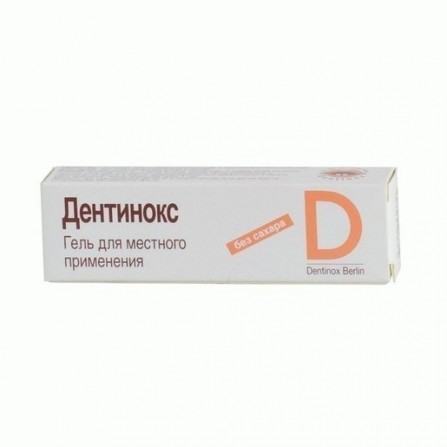More info
Active ingredients
Lauromacrogol-600 + Lidocaine + Chamomile pharmacy flowers extract
Release form
Gel
Composition
Active ingredient: Polidocanol 600 - 3, 2 mg, Lidocaine (in the form of hydrochloride) - 3, 4 mg. Chamomile infusion - 150 mg. Excipients: xylitol, sorbitol, propylene glycol, sodium edetate, polysorbate 20, carbomer, saccharin sodium, sodium hydroxide, menthol, purified water. Concentration of active ingredient (mg): 156, 6 mg
Pharmacological effect
Provides painless appearance of the first incisors, milk teeth and subsequent molars. Prevents irritation of the gums, inflammation of the mucous membrane of the mouth (stomatitis) and painful sensations. The drug is traditionally used to stimulate teething and in order to prevent. Dentinox gel when teething contains sugar substitutes - xylitol and sorbitol - do not cause tooth decay. This prevents tooth decay. Dentinox gel N when teething does not contain preservatives.
Pharmacokinetics
Cabergoline is rapidly absorbed from the gastrointestinal tract, Cmax in plasma is reached in 0.5–4 h, the link to plasma proteins is 41–42%. T1 / 2 of cabergoline is estimated to be 63–68 h in healthy volunteers and 79–2 115 h in patients with hyperprolactinemia. Due to the long T1 / 2, Css is achieved after 4 weeks. 10 days after taking the drug in the urine and kaleobditsya respectively about 18 and 72% of the dose, and the proportion of unchanged drug in the urine is 2-3%. The main product of cabergoline metabolism identified in urine is 6-allyl-8β-carboxy-ergoline at a concentration of up to 4–6% of the dose taken. The content in the urine 3 extrametabolites does not exceed 3% of the dose. It has been found that metabolism products have a significantly lower effect on suppression of prolactin secretion compared to cabergoline. Reception of food affects absorption and distribution of cabergoline.
Indications
The gel is used externally to relieve pain and discomfort during teething. The gel can be used to relieve acute pain and inflammation, as well as for prevention.
Contraindications
Absolute Contraindications to the use of Dentinox gel is intolerance to active and additional substances.
Precautionary measures
Important information about the other components of Dentinox-gel H: This drug, due to its sorbitol content, is contraindicated in patients with rarely encountered inherited fructose intolerance (hereditary fructose intolerance). 10 g of gel contain 1 g of sorbitol (corresponds to 0.25 g of fructose), respectively, less than 0.1 bread unit. Caloric content is 2.6 kcal / g sorbitol. When applied to the oral mucosa, local irritation is possible due to the content of propylene glycol.
Use during pregnancy and lactation
Since this drug is used exclusively to relieve pain during the first dentition in children, there is no information on the use of this drug during pregnancy and lactation.
Dosage and administration
The tool is applied to the gums in the area of the cutting tooth. At one time you should use the amount of gel no larger than a pea. It is recommended to apply the product with a cotton swab or a clean finger. Gel should be gently rubbed into the gums. The frequency of application of the gel - several times a day. The drug is allowed to apply with the appearance of all the molars and primary teeth.
Side effects
The gel in most cases does not cause side effects and well tolerated by patients. Only in isolated cases, the use of the gel leads to the development of local allergic reactions, including redness, rash and itching. The gel does not cause the development of caries, as it contains sugar substitutes.
Overdose
Due to the low dosage of the active substance, as well as the small amount of packaging (10 g), the symptoms characteristic of overdose cases have never been observed. To date, no cases of intoxication have been reported.
Interaction with other drugs
Information about the interaction of cabergoline and other ergot alkaloids is not available, therefore, the simultaneous use of these drugs during long-term therapy with Dostinex is not recommended. Since cabergoline has a therapeutic effect by direct stimulation of dopamine receptors, it cannot be administered simultaneously with drugs acting as dopamine antagonists (phenothiazines, butyrophenones, thioxanthenes, metoclopramide, etc.), becausethey can weaken the effect of cabergoline, aimed at reducing the concentration of prolactin. Like other ergot derivatives, cabergoline cannot be used simultaneously with macrolide antibiotics (for example, erythromycin), since this may lead to an increase in the system bioavailability of cabergoline.
special instructions
Does not cause allergic reactions.



